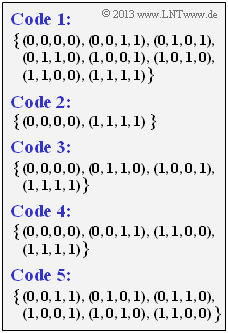Exercise 1.07Z: Classification of Block Codes
From LNTwww
We consider block codes of length $n = 4$:
- the single parity–check code $\text{SPC (4, 3)}$ ⇒ "code 1" with the generator matrix
- $${ \boldsymbol{\rm G}} = \begin{pmatrix} 1 &0 &0 &1\\ 0 &1 &0 &1\\ 0 &0 &1 &1 \end{pmatrix} \hspace{0.05cm},$$
- the repetition code $\text{RC (4, 1)}$ ⇒ "code 2" with the parity-check matrix
- $${ \boldsymbol{\rm H}} = \begin{pmatrix} 1 &0 &0 &1\\ 0 &1 &0 &1\\ 0 &0 &1 &1 \end{pmatrix} \hspace{0.05cm},$$
- the $\text{(4, 2)}$ block code ⇒ "code 3" with the generator matrix
- $${ \boldsymbol{\rm G}} = \begin{pmatrix} 1 &0 &0 &1\\ 0 &1 &1 &1 \end{pmatrix} \hspace{0.05cm},$$
- the $\text{(4, 2)}$ block code ⇒ "code 4" with the generator matrix
- $${ \boldsymbol{\rm G}} = \begin{pmatrix} 1 &1 &0 &0\\ 0 &0 &1 &1 \end{pmatrix} \hspace{0.05cm},$$
- another "code 5" with code size $|\hspace{0.05cm}C\hspace{0.05cm}| = 6$.
The individual codes are explicitly indicated in the graphic. The questions for these tasks are about the terms
Hints :
- This exercise belongs to the chapter "General description of linear block codes".
- Reference is also made to the pages "Single parity–check codes" and "Repetition codes".
Questions
Solution
(1) Statements 1 and 2 are correct:
- That is why there are $\rm 4 \ over \ 2 = 6$ codewords.
- Statement 3 is false. For example, if the first bit is $0$, there is one codeword starting $00$ and two codewords starting $01$.
(2) Statements 1 to 4 are correct:
- All codes that can be described by a generator matrix $\boldsymbol {\rm G}$ and/or a parity-check matrix $\boldsymbol {\rm H}$ are linear.
- In contrast, "Code 5" does not satisfy any of the conditions required for linear codes. For example
- is missing the all zero word,
- the code cardinality $|\mathcal{C}|$ is not a power of two,
- gives $(0, 1, 0, 1) \oplus (1, 0, 1, 0) = (1, 1, 1, 1)$ no valid codeword.
(3) Statements 1 to 3 are correct:
- In a systematic code, the first $k$ bits of each codeword $\underline{x}$ must always be equal to the information word $\underline{u}$.
- This is achieved if the beginning of the generator matrix $\boldsymbol {\rm G}$ is a unit matrix $\boldsymbol{\rm I}_{k}$.
- This is true for "Code 1" (with dimension $k = 3$), "Code 2" (with $k = 1$) and "code 3" (with $k = 2$).
- The generator matrix of "Code 2", however, is not explicitly stated. It is:
- $${ \boldsymbol{\rm G}} = \begin{pmatrix} 1 &1 &1 &1 \end{pmatrix} \hspace{0.05cm}.$$
(4) Statement 1 is correct:
- Dual codes are those where the parity-check matrix $\boldsymbol {\rm H}$ of one code is equal to the generator matrix $\boldsymbol {\rm G}$ of the other code.
- For example, this is true for "Code 1" and "Code 2."
- For the SPC (4, 3) holds:
- $${ \boldsymbol{\rm H}} = \begin{pmatrix} 1 &1 &1 &1 \end{pmatrix} \hspace{0.05cm}, \hspace{0.3cm} { \boldsymbol{\rm G}} = \begin{pmatrix} 1 &0 &0 &1\\ 0 &1 &0 &1\\ 0 &0 &1 &1 \end{pmatrix} \hspace{0.05cm},$$
- and for the repetition code RC (4, 1):
- $${ \boldsymbol{\rm G}} = \begin{pmatrix} 1 &1 &1 &1 \end{pmatrix} \hspace{0.05cm}, \hspace{0.3cm} { \boldsymbol{\rm H}} = \begin{pmatrix} 1 &0 &0 &1\\ 0 &1 &0 &1\\ 0 &0 &1 &1 \end{pmatrix} \hspace{0.05cm}.$$
- Statement 2 is certainly wrong, already for dimensional reasons: The generator matrix $\boldsymbol {\rm G}$ of "Code 3" is a $2×4$ matrix and the parity-check matrix $\boldsymbol {\rm H}$ of "Code 2" is a $3×4$ matrix.
- "Code 3" and "Code 4" also do not satisfy the conditions of dual codes. The parity-check equations of
- $${\rm Code}\hspace{0.15cm}3 = \{ (0, 0, 0, 0) \hspace{0.05cm},\hspace{0.1cm} (0, 1, 1, 0) \hspace{0.05cm},\hspace{0.1cm}(1, 0, 0, 1) \hspace{0.05cm},\hspace{0.1cm}(1, 1, 1, 1) \}$$
- are as follows:
- $$x_1 \oplus x_4 = 0\hspace{0.05cm},\hspace{0.2cm}x_2 \oplus x_3 = 0 \hspace{0.3cm} \Rightarrow\hspace{0.3cm} { \boldsymbol{\rm H}} = \begin{pmatrix} 1 &0 &0 &1\\ 0 &1 &1 &0 \end{pmatrix} \hspace{0.05cm}.$$
- In contrast, the generator matrix of "Code 4" is given as follows:
- $${ \boldsymbol{\rm G}} = \begin{pmatrix} 1 &1 &0 &0\\ 0 &0 &1 &1 \end{pmatrix} \hspace{0.05cm}.$$
